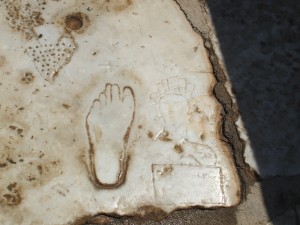This is a picture I took at the site of Ephesus, Turkey. Often called the first example of “modern-style” graffiti, historians believe it is an advertisement for a brothel. Carved into the marble stone is a heart, a foot, a woman’s head, and money. It has been translated as: “turn left at the crossroads where you can buy a woman’s love.” Awesome, right? What really struck me about this is how it disrupts the prevalent viewpoint that graffiti is a modern social ill, affecting inner-city neighborhoods. To the contrary, graffiti is found throughout the ancient world.
J.A. Baird and Claire Taylor note that many archaeologists also project their own negative opinions of graffiti onto ancient groups: “ancient examples are given as evidence of the ‘less educated,’ the ‘subversive,’ or the ‘vulgar’ in ancient societies without much interrogation of the idea” (Baird and Taylor 2011: 1). As I searched for articles on “ancient graffiti” I had trouble because almost all of the ones I found were about modern graffiti defacing prized monuments – from Peruvian ruins to cave art from Utah. Of course this is a huge problem. But how come we don’t hear more about graffiti that was actually created in ancient times? I believe this reflects a bias towards valuing the ancients while devaluing modern graffiti art, no matter how spectacular and artistically creative it is. Banksy anyone? In a couple of thousand years archaeologists might be digging up our own monuments, so lets give them something to look at!
By Luke Griscom Benjamin
References
2011 Baird, J.A. and Claire Taylor. “Introduction.” In Ancient Graffiti in Context, eds. J.A. Baird and Claire Taylor. New York: Routledge.

